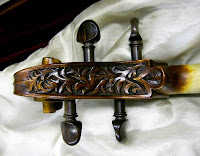i'm having the worst cold of my life. my head has been in a bubble for 6 days now and the computer screen looks blurry. so i've pick today to update VSO#5, since i haven't been to work, school or lessons... ah, why not?
it is time to graduate the top. by that i mean its time to reduce its thickness to tolerable standards. here's the gadget i use:
its no rocket science and i didn't invent it. on one prong of the tuning fork gadget is a stationery rounded dowel. on the othe prong is a pencil stuck in a hole, it is movable so that the distance between the rounded dowel tip and the blunt pencil tip can be adjusted to oh ...say 3mm or whatever... if you pass a thin plank of wood back and forth between the prongs, anything thicker than 3mm will be marked, anything thinner than 3mm won't. piece of cake. looks like this in action:
my next to last pass looked like this:
it is time to mark the sound holes using the high tech method of pencil and tracing paper:
we can begin cutting the holes by stabbing it with a screw driver:
and we can cut it with all the sharp little toys you can buy at the local hobby store:
this finished massacre looks like this. note the holes are not balanced. but i couldn't care less. my cold is killing me. not to mention how they look has no provable effect on sound anyway.
on we go. to make the brace thing that goes underneath the top, i have this stick of quartered spruce which i cut a piece off.:
next comes the rough fit. i do this by looking at the top, looking at the stick, looking at the top again and then winging it with a small plane. i'm sure there are more scientific and efficient ways of doing it, but until i learn them, this works best for me.
the real fitting is done like this. first i mark the the stick, then i lay a long strip of sand paper on the top that has now been clamped onto a form to keep it flat. the stick is pushed back and forth lightly over the sandpaper for 15 mins or so until all the markings disappear :
the brace is glued onto the top, next it is carved and finished out. :
Ta Da:
here's something about the Chi Mei Foundation in Taiwan. it houses some of the world's most precious fiddles of antiquity.
note: Taiwan (the Republic of China) and China (People's Republic of China) are two separate entities.
my rough translation:
国立故宫博物院、奇美博物馆与中时集团时艺多媒体合作,将于9月26日起于故宫推出《 绝色名琴─奇美博物馆提琴珍藏展》,系统性陈述世界名琴400年来的发展史。
The National Palace Museum, Chi Mei ( which translates roughly to "wondrous beauty") Museum and China Times Group Multimedia has teamed up to present an exhibition on the 26th of November at the National Palace Museum called 《 the Legend of Italian Violins - Treasures of the Chi Mei Museum 》systematically detailing the past 400 years of history of the rare violins in its collection.
《绝色名琴─奇美博物馆提琴珍藏展》将首度公开展示奇美珍藏多年的义大利顶级提琴:4 0把包含「阿玛蒂」(Amati)、「瓜奈里」(Guarneri)、「史特拉底瓦里」(Stradivari)家族在内的价值千万名琴,搭配画作雕塑,将带给台湾民众绝 佳的艺术体验。
the 《exhibit》 will for the first time display to the public, 40 instruments worth millions of dollars by master luthiers such as the Amati, Guarneri and Stradivarius families. Matched with paintings and sculpture, citizens
of Taiwan will be able to learn about and experience for themselves rare treasures of unrivaled artistry.
国立故宫博物院院长 周功鑫:「透过琴的展示,结合绘画、雕塑工艺、让琴的本身不再是展示品而让他全方位的 承现。」
National Palace Museum President Chou Kung-hsin ( spelled Zhou Gong Xin in the pinyin system, speaking in Mandarin): "with the exhibition of the instruments accompanied by paintings and sculpture, [cut] they (instruments) will not be viewed as merely objects on display. A fuller experience will be revealed. "
特展中除了13把备受瞩目的义大利3大制琴家族提琴,尚有一组全球唯一收藏于同机构的 「马吉尼四重奏」琴组。在3日的记者会上,邀请台南艺术大学4位教授现场为大家演奏。
besides 13 most admired instruments made by the 3 Italian master luthier families, there will be on display, the world's only string quartet of instruments by Maggini. At the 3rd (of Sept?) press conference, four professors from the Tainan University of the Arts were invited to perform on these instruments.
奇美集团创办人 许文龙:「尤其在音乐里面,任何一个国家关于音乐的事情,音乐里最重要的是小提琴,琴 的事会想到台湾。」
Chi Mei Group Founder Hsu Wen-lung ( spelled Xu Wen Long in the pinyin system, speaking in Taiwanese ) "In music, in any country concerned with music, the most important instrument is the violin, [cut] so in all musical concerns, we all thus think of Taiwan."
奇美博物馆自1990年开始收藏名琴,至今收藏450把,是全世界提琴收藏排名第一的 收藏单位,这些举世难得一见的臻品,已成为国外音乐界及收藏界所钦羡的台湾特色。
the Chi Mei Museum has been collecting fine instruments since 1990, It has now 450 instruments, making Taiwan home to one of the world's most admired premier collection of fine instruments.
新唐人亚太电视 孙帼英 史进旺 台湾台南报导
New Tang Dynasty Asia-Pacific TV 孙帼英 史进旺 reporting from Tainan, Taiwan.
cheers... excuse me while i go OD on orange juice.




























































